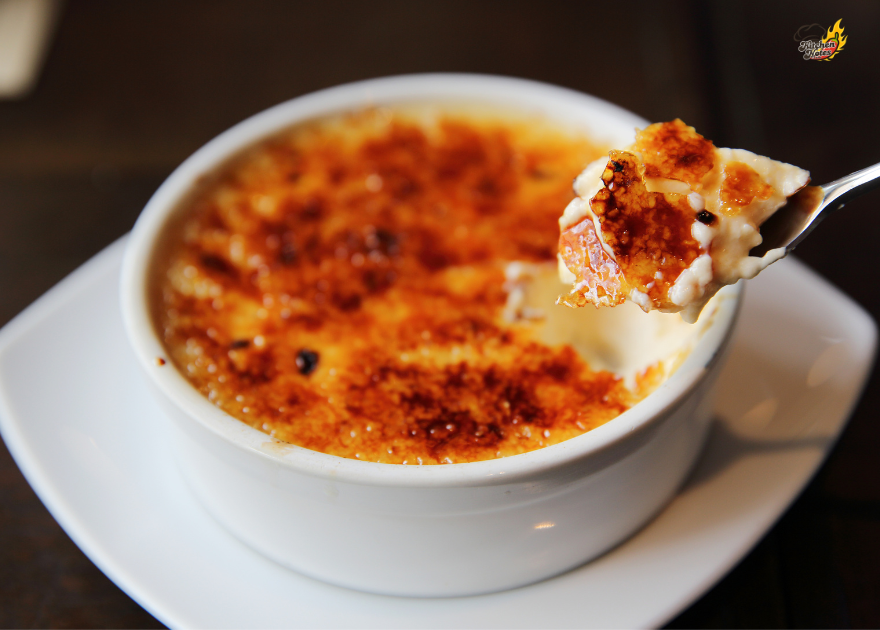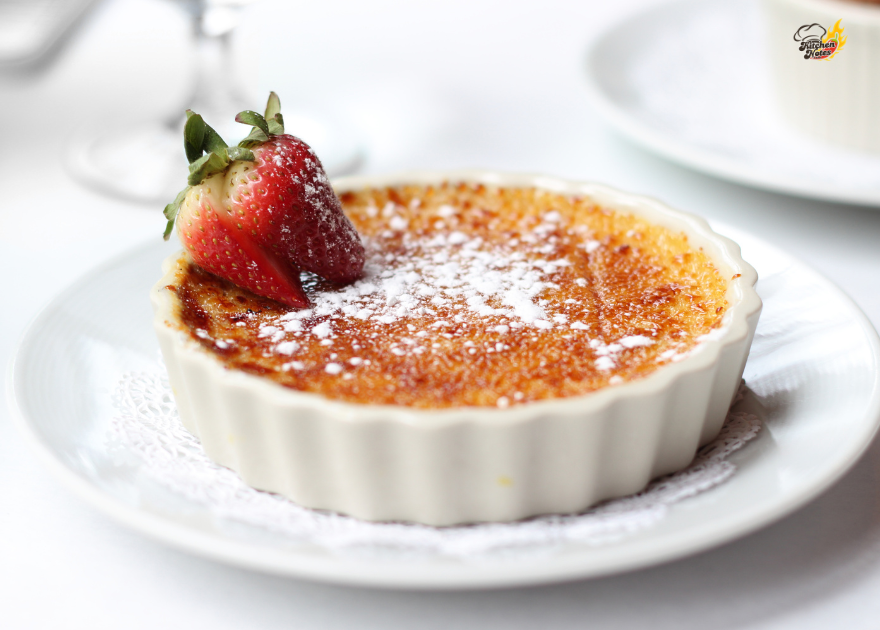Table of Contents

Introduction :
There’s a sound. You know it. The sharp tap of a spoon breaking through the
glassy surface of caramelized sugar. Then comes the velvet. That creamy, rich
custard underneath. Silky, cool, and indulgent. It’s a dessert that demands
silence, a moment, maybe even a small sigh.
Crème Brûlée isn’t loud. It
doesn’t shout across the table. It waits. Elegant. Sophisticated. Almost smug.
And when you take that first bite, it wins. Every time. It’s French. It’s fancy. It’s
deceivingly simple. And yes, it’s got a name that feels like silk on the
tongue, Crème Brûlée.
Whether you first had it at a candle-lit bistro in Paris
or stumbled on it at a small-town restaurant trying to be posh, you remember.
It’s that kind of dish. Memorable. Beautiful. Untouchable. Until now. Because
here’s the truth: Crème Brûlée is not out of reach. Not anymore. Not with a
little patience, a water bath, and yes—a blowtorch.
History of the Crème Brûlée:

Let’s take a brief detour. Back in time. France? Maybe. England? Possibly.
Spain? Why not. The origin of Crème Brûlée is a bit of a culinary mystery. Like
all great stories, it’s got a few claimants. The French, of course, stamp their
name on it. “Burnt cream,” that’s what it means.
A creamy custard with a
scorched sugar top. Classic. But hold on. The English had something called
“Trinity Cream” in the 17th century at Trinity College, Cambridge. Same
idea, custard, sugar, scorched top. Their twist? The school crest was
branded on top with a hot iron. Very Hogwarts.
Then there’s the Spanish
Crema Catalana. A citrus-zested cousin of our beloved brûlée, usually served
on Saint Joseph’s Day. So who’s right? Honestly… who cares? All we know is
this dish has survived centuries. It’s moved across borders. Changed slightly.
But that soul, that contrast of crunch and cream, it remains. And that’s all
that matters.
Ingredients of Crème Brûlée :

Here’s where we gather the magic. Simplicity, dressed in elegance.
For the custard:
● 2 cups heavy cream
● 1 vanilla bean (or 1½ tsp pure vanilla extract)
● 5 large egg yolks
● ½ cup granulated sugar
● Pinch of salt
For the topping:
● 4 to 6 tablespoons granulated sugar (for torching)
Optional:
● Fresh berries or mint for garnish
● A splash of liqueur (think Grand Marnier or Amaretto) if you’re feeling
extra
No fluff. No fuss. Just five core ingredients, maybe six. But oh the
transformation.

Directions of Crème Brûlée :
This is not fast food. This is a ceremony. But you’ve got this. Let’s break it
down.
- Prep the oven.
Set your oven to 325°F (160°C). Boil some water. You’ll need it for the water
Bath later. - Infuse the cream.
Pour the cream into a saucepan. Slice the vanilla bean down the middle.
Scrape those fragrant seeds into the cream, then toss the pod in too. Heat
gently just until steam begins to rise. Don’t boil it. Just warm. Let it steep for
10–15 minutes. If using extract, add it after removing from the heat. - Mix the yolks.
In a bowl, whisk the egg yolks, sugar, and a tiny pinch of salt until smooth and
pale yellow. Steady, gentle whisking. Not foamy. - Temper the eggs.
This is the part where people get scared. Don’t be. Slowly pour the warm
cream into the yolk mixture. A little at a time. Whisk constantly. The goal is to
warm the eggs without scrambling them. This is custard, not breakfast. - Strain.
Pour the mixture through a fine mesh sieve into a large measuring cup or
bowl. This catches any lumps or rogue egg bits. Smoothness matters. - Pour and bake.
Divide the custard evenly between 4 to 6 ramekins. Place them in a deep
baking dish or roasting pan. Carefully pour that boiling water around the
ramekins about halfway up the sides. This gentle bath keeps the custard
from cracking. Cover loosely with foil if you want a softer top. Bake for 35–45
minutes. They should jiggle slightly in the center like Jell-O, not soup. - Chill.
Remove ramekins. Let them cool at room temperature. Then refrigerate for at least 4
hours. Overnight is even better. Patience pays off. - The brûlée.
Right before serving, sprinkle 1 to 2 teaspoons of sugar over each custard.
Spread it evenly. Then torch time. Use a kitchen torch to caramelize the
sugar. Move in circles. Watch it bubble, then settle into amber glass.
No torch? Use a broiler. Set the ramekins under high heat for 1–3 minutes.
Watch like a hawk. Sugar burns fast. Let the sugar cool and harden.
Then tap. Crack. Dive in.
Nutrition Facts (Per Serving):
● Calories: 561
● Total Fat: 50g
● Total Carbohydrates: 24g
● Protein: 6g
Serve It With:
The moment you’ve waited for.
Crème Brûlée is best served chilled, with that warm, brittle sugar top. That
contrast? Divine. Each spoonful should be creamy, cool, with a hint of warmth
from the freshly torched crust.
Add fresh berries if you like. Maybe a mint leaf. But honestly, it needs nothing.
The custard speaks for itself.
Serve it at dinner parties. Bring it to date night. Make it on a Tuesday, just
because. It’s a dessert for moments. Big or small.
Storage:

Crème Brûlée stores surprisingly well. Once baked and cooled, cover the
ramekins tightly with plastic wrap. Keep them in the fridge for up to 3 days.
Important: Do not torch the sugar until you’re ready to serve. The caramel will
soften over time in the fridge, losing its signature crunch.
Need to prep ahead? Make the custards a day or two early. Then brûlée on
demand. That way, each bite delivers the contrast it was born to have.
Tips & Variations (Short & Sweet) :
Quick Tips for Success
● Don’t overbake. Custard should jiggle slightly. Not stiff.
● Use a water bath. No skipping. Prevents cracks.
● Strain the mix. Silky-smooth texture every time.
● Chill well. At least 4 hours. Overnight? Even better.
● Torch last minute. Caramel gets soggy if done early.
● Use fine sugar. Melts evenly. Better crust.

Easy Flavor Twists
● Citrus Zest – Brightens with lemon or orange.
● Lavender – Floral and light. Steep briefly.
● Espresso – Adds rich, bold depth.
● Berry Bottom – A sweet surprise under the custard.
Why We Love It :
Let’s be real. There are a thousand desserts. Cakes, pies, tarts, soufflés. All
wonderful. All worthy. But Crème Brûlée? It’s different. It’s a whisper, not a
shout. It’s not trying too hard. It knows what it is. It’s the perfect union of
texture. Crackle on top. Silk underneath. It plays with heat and cold. With
elegance and simplicity.
With restraint and indulgence. And the experience of
breaking that sugar top? It’s almost primal. There’s something so satisfying
about it. It’s a dessert as a performance. Plus, it’s easy to impress with. Even
if your custards aren’t perfect (maybe a little overbaked, maybe a bit wobbly),
a caramelized top hides many sins.
Conclusion:
It’s proof that elegance doesn’t need extravagance. That perfection can come
from five ingredients and a steady hand. And yes, you can make it at home.
With patience. A little technique. A torch (or not). You’ll get there. So go
ahead. Crack that top. Spoon into that custard. Let it melt, slowly, luxuriously.
And don’t forget to close your eyes. Because of that? That right there is
magic.
Also, I wrote an article about Sugar Cookies. In learn this article, you will learn how to cook homemade Sugar Cookies.